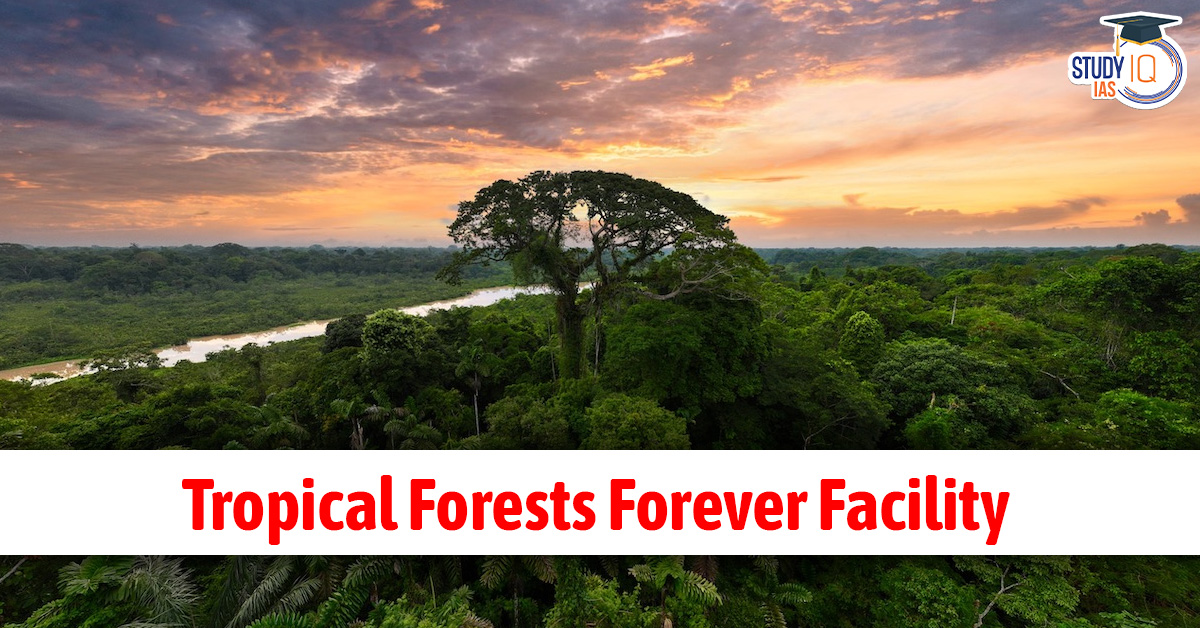Table of Contents
At the COP30 Climate Summit held in Belém, Brazil, President Luiz Inácio Lula da Silva unveiled the Tropical Forests Forever Facility (TFFF) — a groundbreaking $125 billion fund to reward developing countries for conserving their tropical forests.
Lula hailed the fund as an “unprecedented initiative”, emphasizing that it empowers Global South nations to play a leading role in climate change mitigation and forest conservation.
While the TFFF marks a major milestone in environmental finance, experts remain divided over its financial sustainability, transparency, and potential impact on existing UN climate mechanisms.
What is the Tropical Forests Forever Facility (TFFF)?
The Tropical Forests Forever Facility (TFFF) is a self-sustaining international investment fund aimed at rewarding developing nations for preserving their old-growth tropical forests — the world’s most vital carbon sinks.
Primary Goal
To reverse the economic incentives that currently make deforestation more profitable than conservation.
The TFFF seeks to ensure that forests are “worth more alive than dead” by offering financial rewards to nations that maintain their forest cover, using satellite-verified data to track results.
TFFF Fund Structure and Financing Model
The Tropical Forests Forever Facility plans to raise $125 billion in total:
-
$25 billion from governments and philanthropic organizations
-
$100 billion from private sector investments
How It Works
-
Capital Investment:
Funds are invested in public and corporate bonds globally. -
Annual Returns:
The investment returns — not the capital — are distributed as annual payments to forest nations. -
Performance-Based Payments:
Payments are based on satellite-tracked canopy data, rewarding countries that successfully prevent deforestation and preserve biodiversity.
Initial Contributors
| Country/Organization | Contribution |
|---|---|
| Brazil | $1 billion |
| Indonesia | $1 billion |
| Colombia | $250 million |
| Norway | $3 billion (over 10 years) |
| Netherlands | $5 million |
| Portugal | €1 million |
In total, up to 74 tropical forest nations — from South America, Africa, and Southeast Asia — could benefit from the TFFF’s incentive mechanism.
Why the TFFF Matters: A New Model for Climate Finance
1. Makes Forest Conservation Economically Competitive
Historically, countries have cleared forests for soy, palm oil, and timber, as these industries generate quick profits.
The TFFF changes this equation — offering steady financial returns for keeping forests standing rather than clearing them.
2. A Permanent, Self-Financing Mechanism
Unlike traditional climate funds that rely on annual donations, the TFFF invests its capital and uses returns to finance conservation, ensuring long-term sustainability.
3. Strengthening Global South Leadership
The initiative shifts power to the Global South, allowing tropical forest nations — often at the frontline of climate change — to lead global biodiversity protection efforts.
4. Helps Achieve Paris Agreement Goals
Tropical forests absorb about 25% of global CO₂ emissions.
By reducing deforestation, the TFFF can significantly contribute to meeting the 1.5°C climate target.
Mechanism of the Tropical Forests Forever Facility
Step 1: Fund Creation
Governments, philanthropies, and private investors contribute to the $125 billion endowment.
Step 2: Investment
The endowment is invested in global bond markets to generate stable annual returns.
Step 3: Monitoring
Forest conservation progress is monitored through satellite imagery and AI-based canopy analysis.
Step 4: Reward Distribution
Returns are distributed annually to countries based on verified forest cover preservation.
Key Objectives of TFFF
-
Promote forest conservation through financial rewards
-
Build a self-reliant global climate finance system
-
Empower developing nations to lead conservation policies
-
Create a permanent fund independent of UN bureaucracy
-
Recognize the economic value of ecosystem services such as carbon storage and biodiversity
Challenges and Criticisms of the TFFF
Despite its promise, the TFFF faces several economic, institutional, and political challenges.
1. Vulnerability to Market Fluctuations
The TFFF’s reliance on bond markets makes it susceptible to global financial instability.
If a financial crisis hits, like in 2008 or during COVID-19, returns could drop, disrupting payments to forest nations.
2. Weakening Developed Countries’ Climate Responsibilities
Since the TFFF operates outside the UNFCCC, critics argue it could dilute the accountability of developed countries to provide public climate finance under global agreements.
3. Risk of Undermining UN Climate Mechanisms
The facility could undercut established programs such as:
-
Green Climate Fund (GCF)
-
REDD+ (Reducing Emissions from Deforestation and Forest Degradation)
-
Loss and Damage Fund
Experts fear the TFFF might divert attention and resources away from these UN-backed initiatives.
4. Lack of Transparency and Oversight
Questions remain about:
-
Who will manage the TFFF?
-
How will payments be verified?
-
What safeguards will prevent corruption and greenwashing?
Without clear governance, accountability could be compromised.
Expert Reactions
-
FAO Climate Analyst Dr. Maria Torres:
“The TFFF is a creative solution, but unless it’s transparent and inclusive, it could repeat past failures of market-based conservation.” -
WWF International:
“For this fund to work, it must directly involve local and indigenous communities, who are the true guardians of forests.” -
UNEP Finance Initiative:
“The TFFF could redefine climate finance — if implemented with strong monitoring and equity.”
India’s Perspective on the TFFF
Although India is not among tropical forest-rich countries like Brazil or Indonesia, the TFFF provides an important model for:
-
Designing domestic carbon markets
-
Scaling green credit programs
-
Promoting payment for ecosystem services (PES) schemes
India can draw lessons from the TFFF to strengthen its National Mission for Green India and Compensatory Afforestation Fund (CAMPA).
Future Prospects of the TFFF
The success of the Tropical Forests Forever Facility will depend on:
-
Investor confidence and market stability
-
Transparent governance and verification mechanisms
-
Integration with global frameworks like the Paris Agreement
If managed effectively, the TFFF could become the largest environmental finance initiative in history — reshaping the world’s approach to tropical forest conservation.
Conclusion
The Tropical Forests Forever Facility (TFFF) is a bold step toward valuing forests not just as natural resources, but as living assets essential for humanity’s survival.
By offering economic incentives for conservation, Brazil’s initiative could become a transformative model for global climate finance.
However, its long-term success will depend on transparency, accountability, and global cooperation — ensuring that it complements, rather than replaces, existing climate funding mechanisms.
As the world faces increasing deforestation and climate risks, the TFFF could mark a turning point — if it manages to balance financial innovation with environmental justice.


 India Needs Nutritional Transformation: ...
India Needs Nutritional Transformation: ...
 Policy Framework on Forest Tribe Relocat...
Policy Framework on Forest Tribe Relocat...
 State of Food and Agriculture Report (SO...
State of Food and Agriculture Report (SO...

























